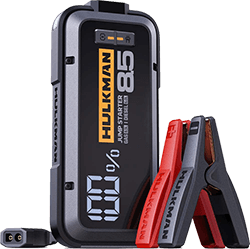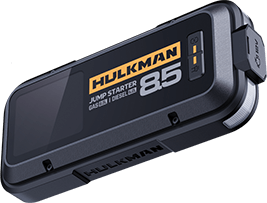Recent Articles
-
Understanding Lithium Battery Charging: Principles, Challenges, and How Hulkman Mega Engineers a Smarter System September 29, 2025
-
What Are Lithium Battery Cycle Counts and How to Extend Them? September 25, 2025
-
How to Properly Care for Lithium Battery Products September 24, 2025
Featured Products
note
Why Power Stations Must Handle Freezing Cold: U.S. Winter Data & Choosing Mega for Reliable Cold-Resistant Energy
U.S. winters are still brutally cold, and standard batteries can’t keep up. While the EPA reports that average winter temperatures have risen about 3 °F since the 1890s, NOAA data shows states like Minnesota, Montana, and North Dakota still see January lows well below 0 °F. That kind of cold drains lithium batteries rapidly — whether in cameras, phones, drones, or portable power stations. Photographers report full batteries dying within minutes at −4 °F. Ice fishers say sonar units barely last half a day. Ski campers warn that phones shut off overnight unless kept close to the body. When power is mission-critical, you need equipment designed to function in sub-zero temperatures — not just advertised for it.
In this article, we’ll cover:
- EPA and NOAA data on U.S. winter conditions
- Why standard batteries fail in freezing temperatures
- Real-world winter scenarios where portable power fails
- Conclusion: Mega is a power station for year-round reliability
EPA and NOAA data on U.S. winter conditions
Winters across the U.S. remain extreme. EPA climate indicators show average winter temperatures have risen about 3 °F since 1896, but cold persists. (EPA) According to NOAA data, January lows in Minnesota, North Dakota, and Montana average well below 0 °F, while Colorado and Utah dip into single digits. (NOAA Climate at a Glance) For millions of Americans, this means facing conditions where a power station to run critical devices must survive sub-zero weather.
Here are stories from people who have felt that “must survive” moment firsthand:
On CaptureLandscapes, a landscape photographer from Minnesota writes:
“Over the past 7+ days, we had −10 to −14 °F here in the Twin Cities (−23 –25 °C), and I was shooting every day (twice) about an hour each, in part to also train for extreme cold weather shoots. Batteries really do drain fast in extreme cold, one time I even had a malfunction of one camera due to the cold, and of course, also peripheral battery devices such as iPhones may just die on you.” (CaptureLandscapes)
In medium-format camera forums, a user reports:
“I was out shooting this past weekend in the winter here in upstate NY—my full battery died within about 15 mins (it was about 20 °F).” (L-Camera-Forum)
A photography lover posting in “How bad is battery drain in the winter?” on Reddit shared:
“I will only be using a Canon 5D Mark III … weather will be around two degrees on average … Batteries lose bars fast—even when not using the camera.” Another user replied that storing spare batteries in inner pockets kept them warm, which helped salvage shots. (Reddit)
Why standard batteries fail in freezing temperatures
Cold weather reduces performance at a chemical level. Electrolyte viscosity rises, slowing lithium-ion movement. At −10 °C, diffusion drops two orders of magnitude, and by −20 °C, ionic conductivity is just 20% of normal.
This creates three major risks:
- Lithium plating blocking anodes.
- Dendrite formation that can puncture separators.
- Dead lithium after dendrites fracture, permanently reducing capacity.
That’s why charging in the cold damages batteries more than discharging — and why a power station that can run in sub-zero temperatures is critical.
Real-world winter scenarios where portable power fails
Cold weather can cut outdoor power lifelines short:
Photography — missed shots when cameras die
Winter landscape and astrophotography communities are full of first-hand reports of batteries failing mid-shoot, causing missed shots and malfunctioning bodies. As CaptureLandscapes warns, “thanks to the cold temperatures, it takes next to no time before the battery is empty — and if you don’t bring several extras, that could mean you miss a shot.” Many forum threads echo the same pain: photographers report cameras cutting out, shutter failures, and displays blanking in sub-zero conditions, often only fixed after swapping in warm spare batteries kept in a pocket. (CaptureLandscapes)
Ice fishing — sonar and fish finder battery drain
Anglers also report that fish finders and sonar units lose usable operating time in cold weather. On ice-fishing forums and Reddit, users frequently describe devices that used to run a full day now barely lasting a few hours when temperatures plunge, forcing early retreats or missed bites. One user comparing models notes a dramatic drop in runtime moving from an older unit to a higher-power sonar in cold conditions. (In-DepthOutdoors ice fishing forum ; Reddit)
Ski camps — phones and laptops shutting off overnight
Backcountry and ski-camp guides repeatedly advise keeping phones and GPS units close to the body because cold will deplete batteries rapidly and can force devices to shut down overnight. REI’s backcountry guide and Ski Magazine both point out that phones “may even power down” in very cold weather and recommend insulating devices or using warm pockets and hand warmers to preserve life. That’s a real operational problem for multi-day camps where crews need reliable comms and mapping. (REI guide ; Ski Magazine)
Winter field expeditions — data risk and shortened mission time.
Scientists and expedition teams report that low battery endurance shortens sampling windows and increases risk to data integrity. Research coverage and lab reports note that extreme cold increases internal resistance and reduces capacity, which can force teams to cut experiments short or lose telemetry if power fails. News and research outlets (and community posts from field teams) recount cases where malfunctioning batteries on remote instrumentation forced mission changes or early evacuation. See explanatory coverage in Wired and technical reviews documenting why electronics are vulnerable in severe cold. (Wired explainer)
Even heating becomes urgent. A 576 Wh power station for an electric blanket can provide several hours of comfort in sub-zero nights.
For many outdoor users, the question isn’t just How many appliances can power stations support? It’s whether the power station can actually function in freezing weather.
Conclusion: Mega is a power station for year-round reliability
Unlike standard units, the Mega operates at −4 °F (−20 °C). This means:
- All-season performance across the U.S.
- Better cold retention: NCM batteries can power up to 70–80% capacity at −10 °C, compared to LFP at 50–60%.
- Dependable UPS function: critical during winter outages.
Simply put, Mega is the power station to run your adventure, your work, and your safety through all four seasons.






















